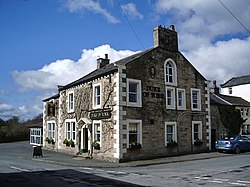Grindleton
| Grindleton | |
| Yorkshire West Riding | |
|---|---|
 The Duke of York Pub, at the bottom of Main St | |
| Location | |
| Grid reference: | SD758455 |
| Location: | 53°54’22"N, 2°22’5"W |
| Data | |
| Population: | 772 (2011) |
| Post town: | Clitheroe |
| Postcode: | BB7 |
| Dialling code: | 01200 |
| Local Government | |
| Council: | Ribble Valley |
| Parliamentary constituency: |
Ribble Valley |
Grindleton is a village and civil parish in the West Riding of Yorkshire. Its 3,700 acres sit within the Forest of Bowland. The civil parish corresponds to the township of the ancient parish of Mitton and had a population of 772 in 2011.[1]
History
Craven in the Domesday Book shows that until 1066 Earl Tostig was lord of Grindleton and the surrounding areas of West Bradford, Waddington, Bashall Eaves, Great Mitton, Hammerton, Slaidburn, Dunnow, Newton, Bogeuurde, Easington, Radholme Laund and Lees. This amounted to 36 carucates (ca. 5,580 acres) of ploughland. The Norman conquest added it to the extensive lands of Roger de Poitou.[2]
A caput manor in Domesday, Grindleton was subsumed into the Liberty of Slaidburn in the second half of the fourteenth century. Bowland underwent wholesale manorial reorganisation at that time, perhaps in response to the fall in population caused by the Black Death (1348–50) and the absorption of Bowland into the Duchy of Lancaster.[3]
Both Grindleton and Slaidburn fell under the ancient Lordship of Bowland which comprised a Royal Forest and a Liberty of ten manors spanning eight townships and four parishes and covered an area of almost 300 square miles on the borders of Lancashire and Yorkshire.[4] The manors within the Liberty were Slaidburn (Newton-in-Bowland, West Bradford, Grindleton), Knowlmere, Waddington, Easington, Bashall Eaves, Mitton, Withgill (Crook), Leagram, Hammerton and Dunnow (Battersby) .[5]
Grindletonians
The Grindletonians were a small nonconformist Christian dissenting sect founded at Grindleton in the early part of the 17th century. The group's leader was Roger Brearley (or Brierley, Brereley) (1586–1637), a curate who worked at Grindleton, Kildwick and Burnley. The beliefs of the sect are unclear, but seem to have included Antinomianism, anti-clericalism and the concept of an earthly Paradise.
Media gallery
References
- ↑ "Civil Parish population 2011". http://www.neighbourhood.statistics.gov.uk/dissemination/LeadKeyFigures.do?a=7&b=11124040&c=Grindleton&d=16&e=62&g=6442473&i=1001x1003x1032x1004&m=0&r=1&s=1453304386633&enc=1. Retrieved 20 January 2016.
- ↑ Dr. Anne Williams and Prof G H Martin, ed (1992). Domesday Book a Complete Translation. Penguin Books. ISBN 978-0-14-143994-5.
- ↑ C J Spencer and S W Jolly, 'Bowland: the rise and decline, abandonment and revival of a medieval lordship' The Escutcheon: Journal of the Cambridge University Heraldic & Genealogical Society 15, 2010 Download
- ↑ "Lord of the Fells, Guardian of History". Rural Life. November 2014. http://www.forestofbowland.com/files/uploads/pdfs/lord_bowland.pdf.
- ↑ Forest of Bowland official website
Outside links
| ("Wikimedia Commons" has material about Grindleton) |





